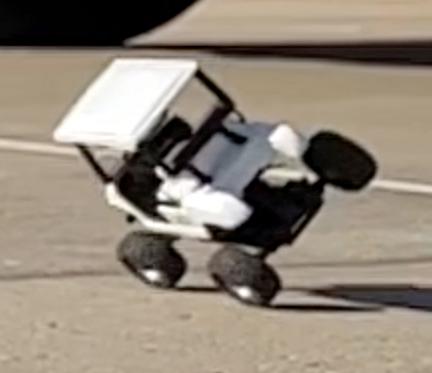
3 minute read
HOW TO BUILD YOUR OWN RC GOLF CART!
If you're like me, and chances are you are, you like to tinker and build things. If you can't find it, you build it. Every once in a while I'll check the internet for a remote control golf cart and always get the same results--zero. I have found a few toy golf carts that are the pull-back-and-go kind, but nothing fancy, lifted or something that could be customized--or so I thought.
While cleaning my office one afternoon, I came across my small collection of golf carts and an idea came to mind. Why not find a mini RC and swap out bodies? With that in mind, I began to search the internet for my donor. A few choices came up but all seemed on the larger side. Then a 1:32 scale high speed buggy popped up, and I knew I found the one. I placed the order that would be arriving at my front door step in two days. Two days turned into three, then four, then five, and it finally arrived. I tore into the package and began to deconstruct my new donor RC and my old golf cart that had been on my shelf collecting dust for over two years.
I thought other people may be interested in my find, so I took out my camera and documented my process. Follow along for the first part of the build.
STEP 1: Taking off the body from the RC is hassle free since it is similar to most larger RCs that you can purchase today. The body is really just a thin plastic shell that pops off of 3 plastic posts. The golf cart involves unscrewing 3 micro screws from the bottom.







STEP 2: With both bodies off, it reveals the small LED light that I wanted to keep, so I needed to make provisions to retain it. To keep the LED light, a hole would be needed on the floorboard of the golf cart.
STEP 3: The golf cart body is a die cast metal part, so I had to drill through the metal brace and the plastic floorboard. After drilling the size hole needed to fit the LED light, it left only a small metal wall on either side, so I ended up just cutting the center support out to give me clean access to the plastic floorboard.
STEP 4: After the LED light hole was drilled, I mated the cart body to the RC chassis and it looked great! I now just needed to figure out how to secure the body to the chassis. I recently bought a 3D printer, and I'm in the process of learning a new 3D program called Blender. Both have a steep learning curve, but I've been able to successfully model and print parts. So I crudely designed what I call a sub frame that uses the RC's plastic post that the original body clipped over, and the screw locations of the metal golf cart body. This would securely mate the two together for the possible torture I would put it through.
Overall, the cart turned out great and looks way better than what it started out. Now was time to put it through its paces and see what it could do. For around $35 (not including my hours) I had a cart that was pretty cool. Of course, since the cart is die cast metal it's pretty heavy, and just like a real cart when lifted, it's also top heavy. Jumping is fun as long as it has a landing ramp, and cornering at high speeds will result in a rollover. It's not much of an off-roader but it will go in the dirt as long as it's not too loose. If you are interested in more details to build your own, you can email me at troy@golfcarting.com and I can provide you with the links to the product I used. Or for $60 I can build one for you. They come in blue, red or white without the logo on the front and number on the side. I'll continue working on this project as I paint it. I'll add some accessories and maybe a new Club Car DS body that I will print.




STEP 5: I set the printer to print low quality so I could see results fast. After tweaking the model on the computer six or seven times and five prints later, I finally had something that was a perfect fit. Below is the final sub frame design.














